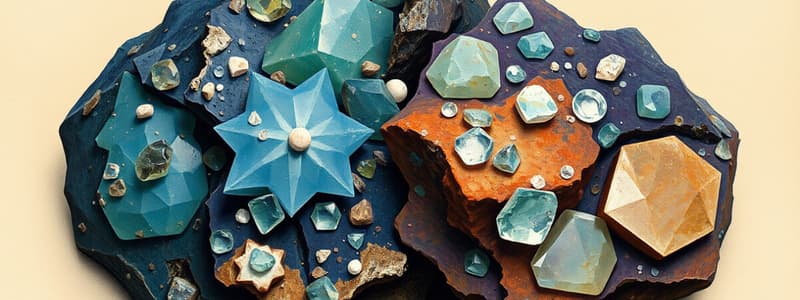Podcast
Questions and Answers
What type of bond is primarily involved in forming the water molecule H2O?
What type of bond is primarily involved in forming the water molecule H2O?
- Metallic bond
- Ionic bond
- Hydrogen bond
- Covalent bond (correct)
In the mineral calcite, what charge does the carbonate ion (CO3) have?
In the mineral calcite, what charge does the carbonate ion (CO3) have?
- Positive charge
- Double positive charge
- Neutral charge
- Negative charge (correct)
What does the presence of a comma in the formula (Mg, Fe)2SiO4 indicate about the mineral olivine?
What does the presence of a comma in the formula (Mg, Fe)2SiO4 indicate about the mineral olivine?
- Magnesium and iron can substitute for each other in the crystal structure. (correct)
- Magnesium and iron are both absent.
- Magnesium and iron occupy different sites in the structure.
- Silicon must be combined with either magnesium or iron.
According to Bohr's model, how many electrons can the second shell of an atom hold?
According to Bohr's model, how many electrons can the second shell of an atom hold?
Which of the following correctly represents the chemical formula of calcium carbonate?
Which of the following correctly represents the chemical formula of calcium carbonate?
What is a key feature that differentiates a mineral from a mineraloid?
What is a key feature that differentiates a mineral from a mineraloid?
Why is calcite considered a mineral in geological terms despite some challenges in its definition?
Why is calcite considered a mineral in geological terms despite some challenges in its definition?
According to the revised definition by the International Mineralogical Association, what condition must a substance meet to be classified as a mineral?
According to the revised definition by the International Mineralogical Association, what condition must a substance meet to be classified as a mineral?
Which of the following substances is explicitly classified as a mineraloid?
Which of the following substances is explicitly classified as a mineraloid?
Which type of rock is primarily formed by the cooling and solidification of molten material?
Which type of rock is primarily formed by the cooling and solidification of molten material?
What are the end-members of olivine?
What are the end-members of olivine?
Which term describes the group of minerals that olivine belongs to?
Which term describes the group of minerals that olivine belongs to?
What plays a crucial role in determining whether a tectonic plate subducts?
What plays a crucial role in determining whether a tectonic plate subducts?
What type of silicate structure is characteristic of olivine?
What type of silicate structure is characteristic of olivine?
Which type of minerals share one oxygen between two tetrahedra?
Which type of minerals share one oxygen between two tetrahedra?
Members of the pyroxene family are typically characterized by which color?
Members of the pyroxene family are typically characterized by which color?
What structural feature connects the tetrahedra in polymerized silicate minerals such as pyroxenes?
What structural feature connects the tetrahedra in polymerized silicate minerals such as pyroxenes?
Which of the following is not a neosilicate mineral?
Which of the following is not a neosilicate mineral?
Which of these minerals is not typically categorized as a dark-colored ferromagnesian mineral?
Which of these minerals is not typically categorized as a dark-colored ferromagnesian mineral?
Which group of minerals includes gemstones such as emerald and aquamarine?
Which group of minerals includes gemstones such as emerald and aquamarine?
Flashcards are hidden until you start studying
Study Notes
Definition and Characteristics of Minerals
- Minerals are naturally occurring, inorganic, solid at room temperature, exhibit a regular crystal structure, and have a defined chemical composition.
- Water and mercury are classified as minerals despite being liquids due to historical classifications.
- Calcite's classification as a mineral is based on geological importance, despite often forming through organic processes.
- The International Mineralogical Association redefined minerals in 1985, emphasizing crystalline formation via geological processes.
Types of Rocks
- Rocks are comprised of one or more minerals or mineraloids.
- Three main types of rocks:
- Igneous: Formed from crystallizing molten material.
- Sedimentary: Composed of mechanically and chemically weathered products.
- Metamorphic: Altered by heat and pressure.
Chemistry of Minerals
- Minerals are specific compounds with defined chemical compositions.
- Chemical bonding forms compounds (e.g., sodium and chlorine form NaCl).
- Molecules, such as water (H2O), are formed through covalent bonding between atoms.
Valence and Charge
- Atoms have electrons in energy levels, with the outermost shell called the valence shell involved in bonding.
- The stability of atoms is achieved by filling the valence shell, leading to the gain or loss of electrons.
Olivine and Ferromagnesian Minerals
- Olivine's formula (Mg,Fe)2SiO4 indicates its chemical structure with interchangeable magnesium and iron.
- Olivine is categorized as a mafic mineral, characterized by iron and magnesium content, and is denser than silicate minerals without these metals.
Tetrahedral Structures
- The silicon-oxygen tetrahedron is a key building block in silicate minerals.
- Neosilicates consist of independent silica tetrahedra (e.g., olivine, garnet).
- Sorosilicates share one oxygen between two tetrahedra (e.g., epidote).
- Cyclosilicates form rings of tetrahedra (e.g., beryl, emerald).
Pyroxene Family
- Pyroxene minerals are dark-colored, typically black or green, and include elements like iron and magnesium.
- Chemical composition includes polymerized silica tetrahedra.
Mica and Clay Minerals
- Mica features a sandwich structure of silica sheets held together by weak Van der Waals bonds.
- Clay minerals form through rock weathering and possess tetrahedral sheet structures.
Common Non-Silicate Minerals
- Oxides such as hematite (Fe2O3) and corundum (Al2O3) are important; corundum forms gemstones like rubies and sapphires.
- Halides include minerals formed by halogens with cations, such as halite (NaCl) and sylvite (KCl).
- Sulfides consist of metals bonded to sulfur, significant examples include galena (lead sulfide) and chalcopyrite (copper-iron sulfide).
- Sulfate minerals, such as gypsum (CaSO4·2H2O), incorporate metal ions with sulfate ions and are widely used in construction.
Studying That Suits You
Use AI to generate personalized quizzes and flashcards to suit your learning preferences.




